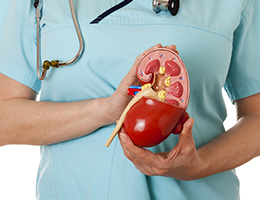
If you have chronic kidney disease (CKD), one of the most important parts of your treatment plan isn't in your medicine cabinet or at your doctor's office.
It's in your refrigerator and pantry.
People who have CKD may need to change their diets to help manage their disease, according to the National Institute of Diabetes and Digestive and Kidney Diseases (NIDDK).
A faulty filter
Healthy kidneys filter waste products from the blood. These products then pass out of the body in urine. Kidneys also help to regulate other things in the blood, including minerals—such as calcium, phosphorus, sodium and potassium.
When kidneys fail, waste can build up in the body and minerals can get out of balance. This can lead to a variety of problems. For example, too much sodium or potassium in the blood can cause serious heart problems.
Too much phosphorus leaches calcium from bones, making them weaker and more breakable. And too much urea (a normal byproduct of protein) can cause poor appetite and fatigue.
4 ingredients to watch
In general, people with CKD need to work to control their intake of the following four ingredients:
1. Sodium. People with kidney disease should get less than 2,300 milligrams of sodium daily, according to the NIDDK. That's because sodium can boost blood pressure.
To reduce sodium intake:
- Check labels for foods low in salt and sodium. Clues include words like sodium-free; low-sodium; low, reduced or no salt; unsalted; or lightly salted. Remember: A daily value (found on the label) of 20% sodium or more means the food item is high in sodium, notes the NIDDK.
- Add flavor with spices. To enhance flavors without salt, use ingredients such as fresh spices, herbs, lemon juice and hot pepper sauce. Be careful with salt substitutes, the NIDDK advises. They may be high in potassium, another nutrient that people with CKD need to watch.
- Cook foods from scratch more often.
- Limit processed foods, including many packaged and prepared foods; canned foods; snack foods; some frozen foods; and most processed meats.
2. Phosphorus. Kidney disease interferes with the body's ability to get rid of phosphorus, so people with CKD should limit their intake of the nutrient, the NIDDK recommends.
Phosphorus (a mineral) is found naturally in foods such as dairy products, beans, peas and nuts. Phosphorus is also added to a variety of foods, including many packaged foods, deli meats, some fresh meats and poultry, and cola beverages.
To find this hidden phosphorus at the grocery store, check the ingredient list on food products for any word with the letters phos (such as phosphoric acid), the NIDDK recommends. Your doctor may have you avoid foods with these ingredients.
Your doctor also may have you take a phosphate binder with meals to help lower your body's phosphorus levels.
3. Protein. Another job of the kidneys is to help remove blood waste products of protein. To help keep these waste products from building up, people with CKD typically need to cut back on how much protein they eat.
According to the NIDDK, people with CKD should eat small portions of protein foods. Appropriate portions are 2 to 3 ounces of fish, chicken or meat; a half cup of milk or yogurt; or one slice of cheese.
Many Americans are used to eating more protein than this, so it can be challenging to make this adjustment and still feel full. The National Kidney Foundation offers these tips for limiting protein without feeling hungry.
- Build sandwiches with thin-sliced meat, flavorful breads and plenty of fresh vegetables.
- Take the focus off meat in main dishes. For example, make rice, pasta, salads and casseroles with small amounts of meat, or serve meat as a side dish and a vegetable or grain as your main dish.
- Eat extra servings of the nonprotein part of your meal.
4. Potassium. This nutrient, found in foods such as bananas, potatoes, tomatoes, dairy, brown and wild rice, bran cereals, whole-wheat bread and pasta, and beans and nuts, helps muscles work properly. How much potassium you need depends on how advanced your CKD is and what kind of medicine you're taking. And your needs may change over time.
In addition to the tips listed above, you may need to watch your calorie or fluid intake. You should also choose a heart-healthy diet, limiting foods high in saturated and trans fats, because heart disease is common among people who have CKD.
Work with an expert
The dietary needs of people with CKD can be quite complicated. So you may want to work with a registered dietitian who specializes in kidney disease nutrition.
For example, a dietitian could show you how to modify recipes to include lower amounts of protein, sodium and other minerals to watch for. That way you can continue to enjoy many of your favorite foods while helping to keep your kidney disease from getting worse.
You can find more information about kidney disease and nutrition at kidney.org.
Reviewed 7/6/2023